Introduction
The Xero Shoes Mesa Trail (8.5 oz / 241 g, $119.99) is a lightweight, minimalist trail runner best used for fastpacking and other fast and light pursuits.
A low stack height, mesh uppers, and moderate tread keeps the shoe light, while welded components and smart design make it surprisingly durable. Huarache-inspired straps on the midfoot and instep allow for precisely dialed fit without causing compression across the top of the foot.

About this Review
This review of the Xero Shoes Mesa Trail will be a Limited Review. I put 500 miles (805 km) on these shoes between January and May of 2020 and another 300 miles (483 km) on a second pair between June and August. Roughly one-fifth of this distance was covered while backpacking under load. Initially, my testing plan called for more backpacking, but Covid-19 interfered with my plans, and I had to cancel several overnight testing trips.
During those backpacking trips I was able to take, my pack weighed between 15 and 45 lb (7 to 20 kgs), depending on the type of trip and season.
I achieved the rest of my miles while trail running. On these runs, I often carried 10 lb (5 kgs) of water and food.
My testing occurred in the Lake Tahoe area of the Sierra Nevada, at altitudes ranging from 6,500 ft to 10,000 ft (1,981 m to 3,048 m).
During my testing, the tread conditions included a few inches of late winter powder, consolidated early spring snowpack, mud, and dry singletrack. In my area, the singletrack is well-packed, but dusty, dirt with periodic loose gravel, boulders, and slab.
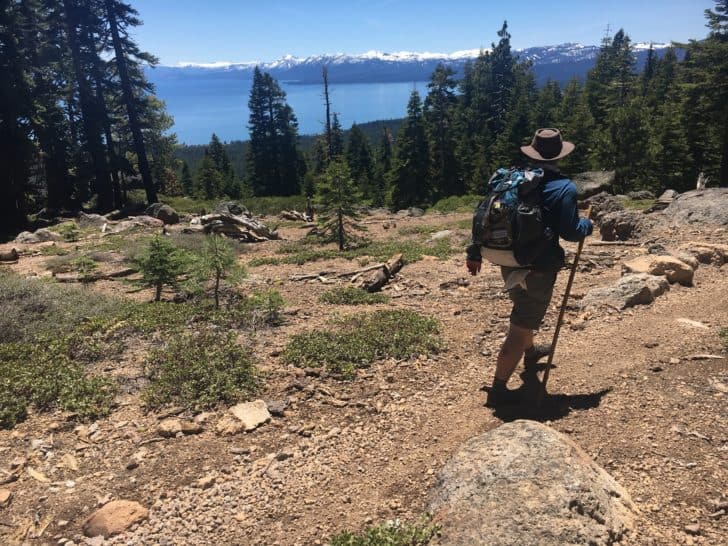
Features and Specifications
- Weight (per shoe, measured, men’s size 9.5): 8.5 oz (241 g)
- MSRP: $119.99
- Fit:
- Claimed: Runs true
- Tested: Size up one-half size if your feet run slightly long for your normal size. Use standard sizing-up procedures to account for foot swellings on long hikes.
- Wide toe-box
- Mesh upper
- Welded lower
- Stitched and bonded rubber toe-box covering (no toe-cap)
- No rock plate or heel cup
- Zero-drop heel
- 10 mm stack height:
- 5 mm outer sole
- 3 mm midsole
- 2 mm insole
- 3.5 mm dual-chevron patterned lugs
- Adjustable instep and midfoot straps
- Vegan friendly
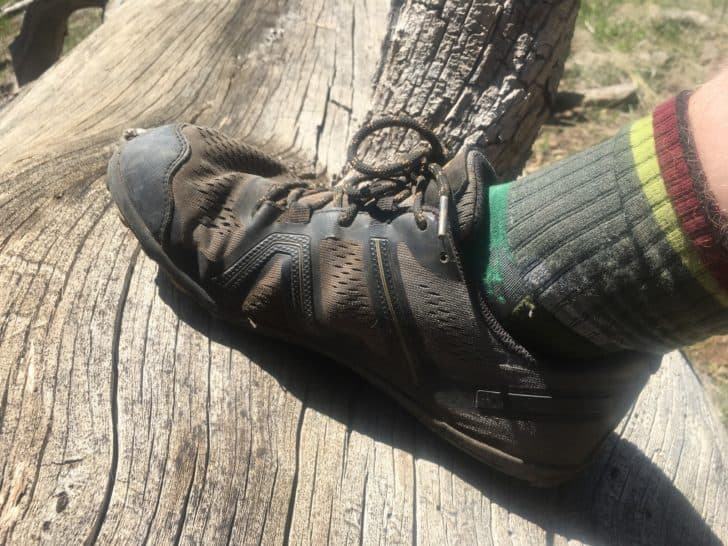
Performance Analysis
Since this is a Limited Review, a detailed performance analysis based on long-term use will not be presented. Instead, performance observations and issues are noted below.
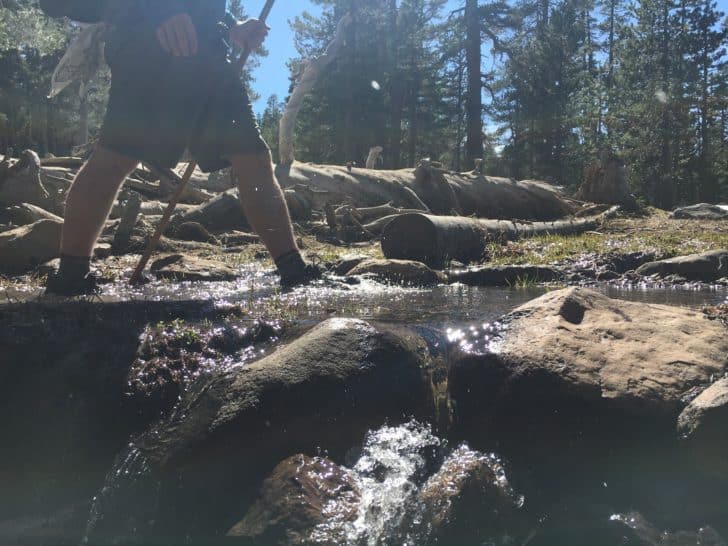
| Criteria | Observations and Issues |
|---|---|
| Fit | A narrow heel combines with minimalist-minded uppers to create a close, stable fit on the shoe’s back end. There’s no heel cup here, so if you are used to one, you might find the heel fit a bit strange at first. Straps run from the bottom of the shoe up to the laces, meaning you can dial in a secure fit without causing undue compression on the top of the foot (this is a feature of many products in the Xero Shoes lineup - they call it huarache-inspired). The toe-box is moderately wide (measuring 4 in / 10 cm in my men’s size 9.5). The Mesa Trails’ toe-box is not as wide as, say, that found on the Altra Lone Peak line, but it is wide enough to do the trick if you like extra toe-space. Consider sizing up if you wear these shoes in shoulder seasons with waterproof socks on top of your normal socks. While Xero Shoes claims these shoes fit true to size, I found them to be slightly short on the downhils. This seems to be the gripe amongst the (very few) negative reviews I could find on third-party websites. And of course, you should follow the general wisdom of sizing up for long hikes to accommodate foot swelling. Once I went to a size ten from my normal nine-and-a-half, I had no issues. |
| Stability and Traction | The low stack height, zero-drop heels, dialed-in fit in the midfoot, and general flexibility of the Mesa Trail inspired a lot of confidence while moving over a variety of terrains. One frequent criticism of wide-toe-box trail runners is a sloppy feel, particularly on off-camber terrain. The Mesa Trail doesn’t have this problem - it felt stable and glove-like while traversing slopes. I believe this performance is a result of two factors: the aforementioned midfoot / instep straps, and the fact that the toe-box, while wide enough to allow for toe spread, is not overly wide. At 3.5 mm, the duel-chevron lugs are moderately aggressive. The shoes handled snowmelt-slick rock like a charm, struggled slightly in thick mud, and floundered on slush and ice. |
| Durability | The durability in these minimalist trail runners is quite impressive - especially for their weight. My original pair of Mesa Trails weathered 500+ miles (805+ km) with minimal compression in the insole, no noticeable compression of the midsole, and minor fraying on the mesh at the instep on both sides of the shoe (both shoes). See pictures in the Commentary section for more info on this fraying. No bonded toe-cap over the front of the toe-box means there’s nothing to peel away immediately as in most trail runners. On top of all this, I found the outsole to be hard-wearing. After 500 miles (805 km) of mixed terrain, the lugs have not measurably worn down. |
| Breathability and Drying Time | Full mesh uppers and minimal padding in the lining around the ankle and heel lead to a shoe that breathes well and dries out quickly. |
| Long-term Comfort | Make no mistake - these are minimalist shoes with only a 10 mm stack height (not counting the 3.5 mm lugs). And as much as this confers other advantages - low weight, stability, confidence, superior ground feel - it does not make for a shoe that is going to baby your feet on high mileage days with a heavy pack over punishing terrain. There’s also no rock plate to pamper you. I pushed the comfort capabilities of these shoes with some 20+ mile days under a 40 lb (18 kg) load. My feet were understandably achy at the end of each day under these conditions - but not more so than when I wore trail runners with thicker midsoles in similar circumstances. Under lighter loads or shorter miles, I experienced no achy feet. My weekly mileage while trail running was about 50 miles (80 km), on average. I should note that I’ve spent the last ten years slowly transitioning to zero-drop minimalist shoes as both a runner and a backpacker. |
Commentary
What makes the Xero Shoes Mesa Trail Unique?
It’s relatively easy to find a trail runner with a zero-drop heel. The same goes for a low stack height, a wide toe-box, a minimalist sole (no rock plate or similar features), a moderate tread, a low weight, or a well-designed lacing system. But to find all of these features in the same shoe is rare.
In my research, I’ve found very few negative reviews of the Mesa Trails – and most of those are related to sizing issues (Xero Shoes has a free return policy around sizing). But it’s worth noting that this is a relatively new product, and the long-term durability (600+ miles / 965+ km) of this shoe is yet to be determined.
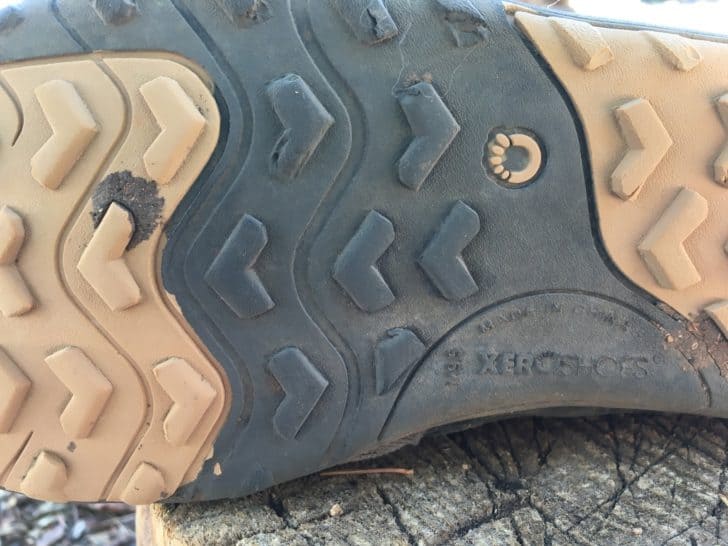
The combination of these features, breathable mesh uppers, and sparing use of fabric and cushioning around the ankles and in the tongue make for a capable backpacking shoe that excels for fast-packing ultralight pursuits in spring, summer, and fall. I’ve paired the Mesa Trails with waterproof socks for running and backpacking in the winter and early spring, and although they are functional for these kinds of trips, there are perhaps better options available.

Of course, minimalist shoes aren’t everyone’s cup of tea – and that’s okay. There’s no need to rehash the minimalist vs. maximalist debate here. But suffice it to say that if you are already a fan of low-drop, wide foot-box shoes with minimal features (and you are okay with a low stack height and a lack of rock plate), the Mesa Trail is worth a hard look.
This recommendation is particularly true for people on a budget. The Mesa Trail is competitively priced at $119.99. On top of that, the shoes will last you longer than anything I can name with a similar feature set, which brings me to my final point, durability of the shoe for its weight.
Durability for Weight
Like many ultralight backpackers, I made the transition from classic leather boots to trail runners with no regrets – save one. I loathe the lifespan of average trail runners, a mileage that seems to be ticking ever downwards as materials get lighter. My last pair of trail runners (Altra Lone Peak 4s) started to fall apart after 200 miles (322 km) – same deal for my last pair of Merrell Trail Glove 4s.

Enter the Xero Shoes Mesa Trail. These sturdy little shoes have lasted 500 miles (805 km), and I expect to get at least 200 more out of them before complete failure. Is that ideal? No. I long for the day I can get 1000 miles out of a lightweight, minimalist shoe. But the Mesa Trail is getting close to that milestone.
No Toe-Cap
First of all, there’s no toe-cap glued to the front of the shoe. In my experience, this is the first failure point on any trail runner. The Mesa Trail has a broad rubber toe-box covering welded to the sole and stitched to the upper. After 500 miles (805 km), this aspect of the shoe shows no signs of failure.

Midsole Durability and Conservation of Materials
The second common failure point in trail runners is compression and breakdown of the midsole. I interviewed Steven Sashen, CEO and developer of Xero Shoes, in preparation for this review. I asked him how he made such a durable shoe for such a small weight penalty. He answered that much of the heft in otherwise lightweight shoes comes from midsole material. Because the midsole of the Mesa Trail is a dense 3 mm EVA foam, it holds up well to repeated compression but adds very little weight to the shoe.

This wiggle room freed the Mesa Trail designers to focus on burly design choices (like the broad rubber toe-box covering and welded protective components, see below) while still maintaining a light shoe.
Mesh Uppers and Welded Components
A third failure point in trail runners is an abrasion-induced failure in the mesh material. Here I finally saw some failure in the Mesa Trail, at around the 450-mile (723 km) mark. The mesh just behind the instep on both feet failed (on either side of the foot). This failure occurred at the only spot on the front three-quarters of the shoe that doesn’t have a welded covering marrying the sole and the mesh upper.

It’s worth noting a few things here. Firstly, this mesh failure on this exact spot occurs in many of my trail runners (prompting Steven Sashen to point out, rightly, that the problem could be my feet, my mechanics, my general terrain, or all of the above.) But it’s also worth noting that this failure occurred at mile 200 (322 km) on my Altra Lone Peaks and went all the way through the shoe (see my photo above). On my Mesa Trail shoes, the failure has stopped at the outer layer of mesh.
A final point – I sent photos of this mesh failure to Xero Shoes and they sent me a new pair, with assurances that this kind of damage is covered under the manufacturer warranty. Steven Sashen in particular was surprised – he said none of their testers had managed to make the shoe wear like this. I’ve put 300 miles (483 km) on the new pair and they are holding up even better than the first pair – which makes me think that the late-winter running conditions (with occasional punching through sharp snow crust) contributed to the failure of the original pair at the 450 mile (724 km) mark.

Compared To…
I considered comparing the Xero Shoes Mesa Trail to trail runners from Altra, Topo Athletics, and Inov-8. At the end of the day, none of the comparisons I considered making matched the Mesa Trail’s mixture of stack height, weight, and minimalist design. While I could have compared the Mesa Trail to products from Lems or Vivobarefoot, in the end, I made a comparison to another Xero Shoes product, the TerraFlex.
The TerraFlex is a more heavy-duty shoe and is designed as a true running/hiking hybrid, while Xero Shoes designed the Mesa Trail for speed and as a dedicated trail runner (with the understanding that some consumers would use it as a minimalist backpacking shoe). I tested the TerraFlex concurrently to the Mesa Trail, so I could get an accurate idea of how each shoe stood against the other.
The Xero Shoes Mesa Trail vs. The Xero Shoes TerraFlex
| Criteria | Comments | Edge |
|---|---|---|
| Weight | Welded components and more mesh make the Mesa Trail a lighter shoe. | Mesa Trail |
| MSRP | The TerraFlex is twenty dollars cheaper. The Mesa Trail is a new product, while the TerraFlex was updated in the last two years. | TerraFlex |
| Durability | The TerraFlex is a heavier, more solidly constructed shoe, with heavier mesh and a higher content of non-mesh components. One would assume this would make for a more durable shoe - but to be fair, I haven’t subjected the TerraFlex to the same amount of miles as the Mesa Trails. | TerraFlex - theoretically |
| Stack Height | Both shoes utilize a 5 mm outsole, a 3 mm foam midsole, and a removable 2 mm insole. | Tie |
| Traction | The TerraFlex has 4 mm lugs, while the Mesa Trail has 3.5 mm lugs. I consider 0.5 mm to be a negligible difference in terms of traction. Honestly, I’d prefer if both shoes had larger, more aggressive lugs. | Tie |
| Fit | Both shoes use the Huarache-inspired design. | Tie |
| Breathability / Drying Time | The Mesa Trail utilizes thinner, more breathable mesh than does the TerraFlex. | Mesa Trail |
Strengths
- Lightweight
- Extremely durable for weight
- Breathable
- Comfortable
- Unique and well designed lace-tensioning system
- Stable and grippy on mixed terrain
- Affordably priced
Limitations
- The minimalist design could limit the trip type and use cases (best for fastpacking, low-mileage days if loads are heavy, or traditional trail running).
- Mesh upper failing just behind instep on both sides of each shoe (after 450 miles / 723 km). Xero Shoes says this failure is covered by warranty and sent me a new pair. Original damage was probably caused by late-season winter running and punching through sharp snow crust. My new pair has not worn in the same way during late-spring and summer backpacking and running.
- I’d personally prefer slightly more aggressive lugs.
Related Content
Reviews:
- New to minimalist footwear? Be aware of the pitfalls. Check out Ryan’s explainer video.
- Want something more burly than a trail runner? Give this review a read.
Forums:
- Our community talks about trail runners a lot. Check out some forum threads here, and here, and here, and here.
Where to Buy
- You can buy the Xero Shoes Mesa Trail here.
DISCLOSURE (Updated April 9, 2024)
- Product mentions in this article are made by the author with no compensation in return. In addition, Backpacking Light does not accept compensation or donated/discounted products in exchange for product mentions or placements in editorial coverage.
- Some (but not all) of the links in this review may be affiliate links. If you click on one of these links and visit one of our affiliate partners (usually a retailer site), and subsequently place an order with that retailer, we receive a commission on your entire order, which varies between 3% and 15% of the purchase price. Affiliate commissions represent less than 15% of Backpacking Light's gross revenue. More than 70% of our revenue comes from Membership Fees. So if you'd really like to support our work, don't buy gear you don't need - support our consumer advocacy work and become a Member instead.
- Learn more about affiliate commissions, influencer marketing, and our consumer advocacy work by reading our article Stop wasting money on gear.

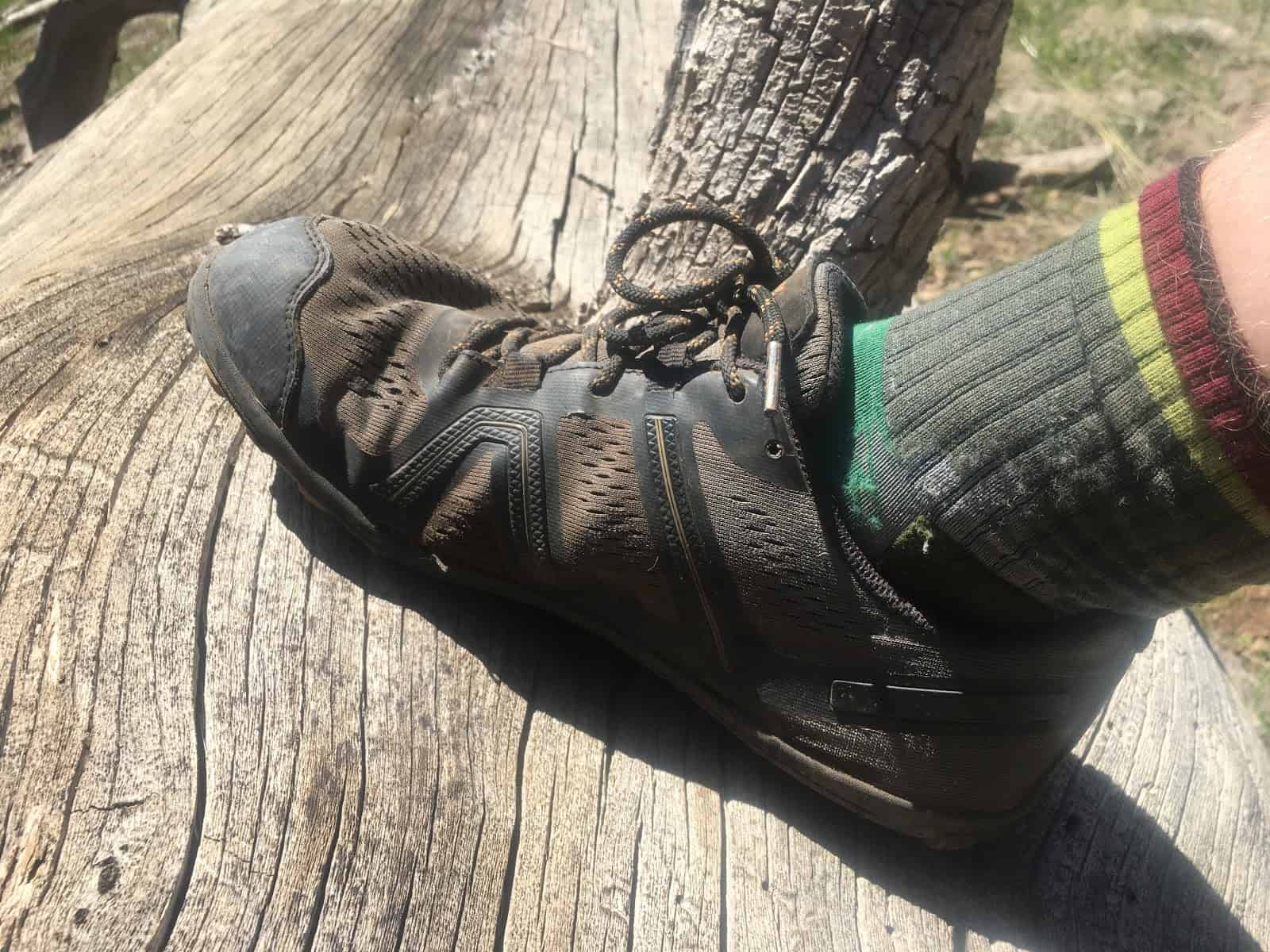


Home › Forums › Xero Shoes Mesa Trail Review